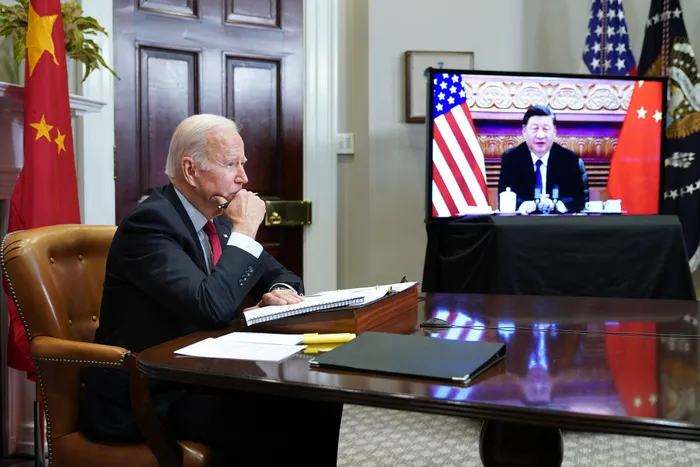US’s self-interest trumps global peace, stability

US President Joe Biden meets with China's President Xi Jinping during a virtual summit from the Roosevelt Room of the White House in Washington. Shortly before the US gave Taiwan financial aid, US Secretary of State Anthony Blinken recently visited Beijing “to boost dialogue”, according to Chinese officials following a telephone call between presidents Xi and Biden, wherein it was reported that Biden reiterated the US’s wish to neither seek a new Cold War nor change the Chinese political landscape and that it did not support Taiwanese independence, the writer says. – Picture: Mandel Ngan / AFP / Taken on November 15, 2021
By Wesley Seale
Nothing since the US invasion of Iraq in 2003 has divided the international community as much as the conflict in Ukraine, which erupted in February 2022.
Two years later, the once-united US is as divided as the international community is on the conflict.
As far back as October last year, in the wake of the escalation of the Palestinian conflict, the Biden administration had to lump an aid package to Ukraine with Israel. Aid to Israel was popular at the time, as it continues to be in the US, whereas sentiments towards Ukraine had waned drastically.
Finally, this past week, the US Congress passed the $95 billion (R1.8 trillion) aid package – $61bn went to Ukraine, $26bn to Israel and $8b to Taiwan.
Humanitarian aid to Gaza was also approved but this is minuscule compared with the aid to the three countries and was also eclipsed by the US veto of full UN membership to the state of Palestine.
It is the Republican party, though, that is most divided on Ukraine.
Donald Trump, and his supporters, had effectively blocked the aid package because he disagreed with the Biden administration’s policy on Nato, Russia and the government in Ukraine, headed by Volodymyr Zelenskyy.
Republicans have also used widespread corruption in Zelenskyy’s regime as another reason for lack of support.
As a side note, the developments in Washington, especially in Congress, confirm the laudable, correct and non-aligned approach the South African government took in respect of the escalation of the conflict.
Convincing the South African government is not the only convincing the Ukrainians have to do.
While the Democrats, who have a majority in the Senate, continue to stand squarely behind their president and Zelenskyy, CIA director Bill Burns warned the Senate Intelligence Committee last month that “without supplemental assistance”, Zelenskyy’s regime “could lose on the battlefield by the end of 2024”.
British Prime Minister Rishi Sunak pledged $620 million in military aid to Ukraine and both the aid packages, and their dire urgency, indicates that the country is losing the war.
While Congress was signing off on Biden’s aid packages, his administration was also considering imposing sanctions on the Israeli military battalion, Netzah Yehuda, among others.
Biden seems to have a carrot-and-stick approach to Netanyahu’s regime in Tel Aviv. The consideration of imposing sanctions comes two years after the killing of 80-year-old Palestinian American, Omar Assad, by soldiers from the battalion.
In response, Netanyahu stated angrily that “if anyone thinks they can impose sanctions on a unit of the (Israeli army he) will fight it with all (his) strength”.
In the meantime, US Secretary of State Anthony Blinken arrived in Beijing “to boost dialogue”, according to Chinese officials. Blinken’s visit follows a telephone call between Chinese President Xi Jinping and his US counterpart, President Joe Biden, wherein it was reported that Biden reiterated the US’s wish to neither seek a new Cold War nor change the Chinese political landscape and that it did not support Taiwanese independence.
Less than 30 days later, Biden was sending $8bn to Taiwan.
This has become the real politick of US diplomacy: playing both sides.
The aid package must though be seen in the larger context of Biden’s 2024 budget allocation of just over $61bn to the US State Department and USAid while the country’s defence budget is between $841bn and $905bn.
The defence budget is therefore nearly 14 times the size of the State Department’s budget and larger than the budgets of the next four countries that spend the highest on defence combined.
Often repeated by senior strategists is that foreign policy is not necessarily an elections issue in the US and this could be because of the close correlations between Republican and Democrat foreign policy.
Yet the aid package, coming from a fundamental cog in the foreign policy wheel of the US, was aimed at Russia, Iran and China. As in the case of Ukraine and now Israel, the US will no longer be eager to enter wars but simply support allies across the globe in fighting their adversaries.
What this means for South Africa is that we should be taking a nuanced approach to our foreign policy.
Non-alignment on Ukraine cannot mean being pro-Russian nor should our stance with the Palestinians exclude engaging with Israeli civil society and progressive forces in that country.
As the Taiwanese liaison office continues to operate in South Africa and give support to our communities, often providing food, we must be able to yield more economic leverage from China and Russia.
American diplomats in South Africa can point out that between 600 and 800 US companies operate in our country and provide jobs for our people.
We are yet to get a figure from the Chinese on how many of their companies operate in South Africa while, recently, a Russian diplomat could not provide a figure. The Chinese may remind us that we are its largest trading partner in Africa but it is direct foreign investment that creates more sustainable jobs through the building of factories, plants and warehouses.
While aid packages fly across the globe, foreign policy rings hollow and the international balance of forces means little when South African lives are not changed for the better in this world.
Dr Wesley Seale has a PhD in international relations and wrote his dissertation on BRICS.